Want to learn How to Optimize Your Content for Better Conversions?
You’re always looking to increase your conversion rate as a brand.
And the reason you’re working with content marketing in the first place is that you are hoping to be able to reach more people, and ultimately increase your conversions, right?
Content marketing has skyrocketed in popularity over the years, and we have Google Trends that prove it. But its increased popularity is not strange considering the immense results it is showing that it’s able to generate.
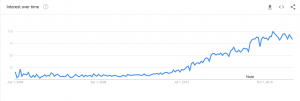
The market is changing, and you need to adapt your business to those changes. And in today’s marketing landscape, content marketing is certainly part of that.
People are tired of brands who are stealing their time with their boring advertisements, and never in the history of this earth has the trust and care for banner ads, TV ads, and traditional ads been as low as it is today.
In order to succeed in the competitive marketing landscape, you can, and should, therefore, embrace content marketing.
Because that means you can drive more sales with marketing that isn’t bothering your customers.
Sounds like a great deal, right?
But the truth is that in order to succeed with content marketing, you cannot just create a few pieces of low-quality content and wait for the results to start rolling in.
Because in reality, they won’t.
Content is an important part of your sales funnel, and it can be used for several different reasons, such as increasing brand-awareness, teaching people about the benefits of your brand, and ultimately, it can convince people to buy from you.
Chances are, you’re here because you’re working with content marketing, but you’re not seeing the conversions you were hoping for.
Anyone can create a piece of content, but to make it convincing, appealing, and engaging, you need knowledge and skills.
In this article, we’ll look at how you can Optimize Your Content for Better Conversions.
Understanding the types of content
The content you put out is your value proposition to your audience. It can be a video, a photo, a blog post, or anything else.
Therefore, the actual content you provide is crucial for having a content strategy in the first place.
If you don’t have content, you have nothing.
But you need to know that content can have a different effect at different stages of your conversion funnel, and therefore, in order to optimize your content marketing conversions, let’s look at the different kinds of content you can use, and when they are suitable to use.
Generally, there are two types of content that are spoken about.
These are awareness content and educational content.
Educational Content
Educational content is meant to teach your audience something, and give your audience knowledge within the niche you’re operating in, which is ultimately meant to spark an interest in the product you are selling.
This is also the part where a lot of marketers screw up.
What they do is start promoting their product and brands like crazy, and thus making people bounce, or stop trusting the content.
Never start talking about the benefits of your products, but instead, showcase how it works, and how it can improve people’s lives. The best part about educational content is that people get something out of it.
It’s not like ads that steal people’s time.
Instead, this type of content actually gives them something they want – it provides them value, but more on that later.
Awareness Content
Next, you have awareness content.
This is the type of content that is used far up your conversion funnel. It is people’s first interaction with your brand, and how you attract prospects to your site, which have the potential converting into paying customers.
Awareness content is ultimately what will get people aware of your brand and products. This is crucial because if you don’t have people’s attention, it will be impossible to convert them into customers.
Now that we got that sorted out, it’s time to dig into what approaches you can take to optimize your content for better conversions.
Provide value
Providing value is the foundation for all successful content marketing.
Think about the traditional advertisements that you see on TV.
Do they bring you any value?
Seldom, right?
All they do is prevent you from seeing the show you want to see.
So what do you do when the ads start playing?
You pick up your phone or do something else!
Obviously, content that provide value is a lot different from the ads mentioned above.
The major difference is that you’re using your content as your value proposition that gets people to come to your content on own will and on own initiative.
Why?
Because it brings them value.
You can bring your audience value in a variety of different ways.
The different ways that are generally spoken about are:
- Information – your content gives knowledge
- Guide – your content teaches how to do something
- Entertaining content- gives your audience a good laugh, entertains, and helps with escapism.
All of these types of content brings value, however, it is important that you’re aware of the fact that different audiences find different things valuable.
So why should you bring value?
When you bring someone value, you’re essentially guilting them into buying from you.
It’s called reciprocity.
Think about it:
If you’ve had a friend that has always been immensely generous and shared lots of things with you, you’ll feel guilty in returning that favor.
What’s more, if that person then asks for a favor, few people have the audacity to say no.
Because the other person has the leverage.
Guilting someone so they buy from you is something that entrepreneur Gary Vaynerchuk is a firm believer in.
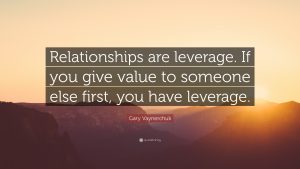
And when it comes to content marketing, the same principle applies!
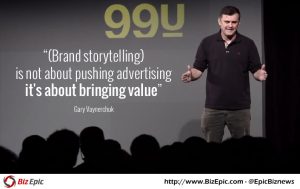
Too many marketers believe that ”well, now that we have an audience, we need to start shoving ads down their throats”, or ”we’re investing all these resources into content marketing, not it’s time to start promoting so we drive sales”, but both of those are completely faulty approaches to this matter.
Because the truth is, people aren’t on your website because they’re eager to buy.
They’re looking at your content because it brings them some kind of value.
And if you, start removing that value and exchange it with promotion, what do you think will happen?
Your value proposition will disappear – together with your audience.
If you have something of value, people will come.
And the thing that all marketers trade on is attention.
By creating and sharing valuable content, you’ll attract people’s attention.
But if you’re just creating promotional messages, you’ll scare away the little drop of attention you have.
This is why it is so important that you understand your audience so you know what they find valuable.
Content marketing is just like SEO, and that’s because content marketing is the foundation for SEO.
Okay, so what does this mean exactly?
It means that if you’re a brand in the healthy food industry, you don’t want to rank for keywords such as ”junk food” or ”soda” unless you’ve written an article that presents the negative effects of all of that.
The reason?
Well, what you’ll ultimately do is attract people who couldn’t care less about your business. This, in turn, will lead to high traffic but a minimal conversion rate.
Therefore, research your audience and what they find valuable, as well as stay in line with your industry and niche when producing content.
Doing so will allow you to only attract relevant people to your website that are much more likely to convert.
Remember: it is better to have 100 visitors that buy than 10,000 that don’t.
Write Compelling Content
While the text isn’t everything, it is probably making up a large part of your content marketing strategy.
But writing content comes with several challenges.
Because the truth is, most people don’t read the majority of the web copy.
In fact, 55% of Visitors Read Your Articles For 15 Seconds or Less.
That hurts for you that invested all this time into creating an appealing copy, and then have people dropping off.
But since you’ve come this far, thank you!
In order to get more people to read your content, so they can actually get impacted by your content and ultimately get convinced to buy from you, you need to be strategic in the content you write and optimize it in a way that encourages people to continue reading.
I’ve written over 800 blog posts, and this is what I’ve learned from it:
- Have a unique personal tone – use ”you” and ”I”. It should be a conversation
- Ask questions – rhetorical or not
- Make your content skimmable – use sub-headings, bullet-points etc.
- Include images – lots of them. Articles with images get 94% more total views than articles without images.
- Bring value. People have come to your content because they are hoping to get value from it. If you can’t deliver, they’ll bounce off. Therefore, you need to be clear, concise, and straight to the point – and avoid using click bait headlines.
When you write about personal events and from the heart, your text will come off as much more authentic, and what will happen is that your copy will be much more engaging. This, in turn, will allow you to convey your excitement in the topic you’re writing about, which will encourage the reader to continue reading, but also impact them much greater. Maybe to the point where they buy from you.
This is why it is crucial to be passionate about the topic you’re writing about because your readers will notice.
Craft more content that is relevant and helpful to your audience
I’ve already spoken quite a bit about providing your audience with value, and this is a part of that.
But the truth is, providing value is the single most effective strategy to optimize your content for better conversions.
It’s impossible to optimize your content for better conversions without optimizing your existing content strategy and the content that already exists, right?
An important part of providing value to your target audience is by thinking about relevance.
The more relevant your content is to your target audience, the easier it will be to convert your audience, right?
The way you provide value is by solving pain points.
And this goes hand-in-hand with what I mentioned earlier.
Because if someone is bored, and you can entertain them with your content, you provide them value.
If they need to know how to do something, and you teach them with your content, you provide them value.
You can begin by looking at the type of content that performs best on your website.
Is it guides? Is it videos? Is it photos?
Identifying that is the foundation to continuing to produce amazing content that performs well, because if you’re investing a ton of resources into creating videos, but nobody is watching them, instead, people are reading your articles, it might indicate something about your audience’s preferences.
Next, you want to look at the types of topics that drive best results.
Are people seeing your brand as a thought leader to which they can go to for information and knowledge?
Do they see your brand as a place to which they can go to be entertained?
This brings me to my next point.
Don’t just produce content, get people to see it
”Content optimization is a critical process; producing more content is not only enough but making it visible to your targeted audience”
If you’re relying on search engine traffic, search engine optimization has to be a part of your marketing strategy.
Almost all businesses are able to have a ”news” section, a blog, or a reports page.
And in fact, many brands do.
By sharing content related to your industry and letting your audience know about the latest events, you start establishing yourself as a thought leader and a brand with good insight into the industry.
But the problem is that just sharing content isn’t everything.
In fact, getting people to see what it is you are sharing is equally, if not more important.
Many brands rely on search engines to drive them traffic and attract relevant people.
Some just wait, while others go out and optimize their page to improve their rankings.
Because the fact of the matter is that the SEO landscape is tremendously competitive.
Therefore, it is now essential that you optimize the content you create to maximize its rankings, and thus also its traffic.
There are a few simple ways you can optimize your content for more traffic:
Keyword research
This is probably the most common form of SEO that brands and people use. The body of your text should contain keywords which you want to rank for, but they should be integrated in a way that doesn’t come off as spammy, or as if you’re using keywords stuffing.
This is why a crucial part of a successful SEO is keyword research. Google offers a popular tool that allows you to look at keywords relevant to your industry, see average monthly searches, and have suggestions for new keywords you can target, by the name of Google Adword Keyword Planner.
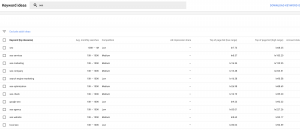
Static URLs
In order to rank, it is essential that each of your posts is created on separate pages and have unique URLs
Emphasise headlines
Headlines are maybe more important than you think.
In fact, 80% of people read headline, 20% of people read copy.
And that’s not so strange, really. People make their first (emotional) decision based on a scan of the headline. If they find the headline interesting, and it sparks curiosity, they’ll begin reading.
Build trust
Trust is the foundation for all successful sales.
Because if your audience doesn’t trust you, they won’t buy from you.
Simple as that.
Your audience won’t care about how amazing your deal is, or how many products they get for 1 unless they don’t trust you.
Would you want to share your credit card details to someone you don’t trust?
Of course not!
This is the reason you must put great effort into developing a website that comes off as trustworthy, and there are several ways you can do this on.
Badges
Badges are probably the most common type of method to make your website look more authentic and trustworthy.
There are plenty of badges out there that you can acquire, but don’t go overboard, because that can have an opposite effect.
You want to use badges such as PayPal, Antivirus, safe e-commerce etc.
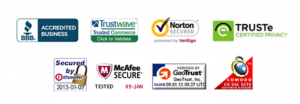
All of this helps contribute to a more safe website, at least by the eyes of the visitor.
HTTPS certificate
Hyper Text Transfer Protocol Secure (HTTPS) is the secure version of HTTP, the protocol over which data is sent between your browser and the website that you are connected to. The added ”S” in HTTPS stands for ”secure”, which means that the communications between your browser and the website are encrypted. It is normally used to protect online transactions and thus making payments online much safer where confidential information is transferred, such as online banking or online shopping order forms.
This means that if you only have HTTP, people might distrust your website, and therefore don’t buy from you.
Plus, not too long ago, Google announced that they would add a “not safe” badge next to the URL of websites which only carry HTTP.
Reviews
A great way to build trust is to incorporate reviews and ratings on your website.
Why?
Because:
- 92% of consumers now read online reviews vs. 88% in 2014.
- Star rating is the number one factor used by consumers to judge a business
- 88% trust reviews as much as personal recommendations
People trust reviews and recommendations, and therefore, you want to implement them on your website to make it more authentic and transparent.
Emphasise social media visuals
Visual content is tremendously important in marketing.
And while text helps you rank on Google and give you exposure, people don’t go to social media to read pages of text.
They go there to have a good time.
And this is what images allows them.
Because the truth is that humans resonate a lot better with visual content than with text.
Us humans are wired that way.
And for you, that’s a good thing, because it also means that by leveraging the power of visual content, you can convey your point better, make a greater impact, and ultimately get your audience to convert.
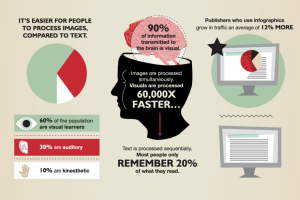
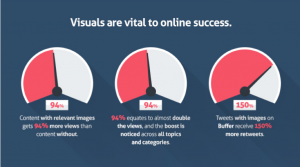
Social media is a tremendous place for marketers and brands to be, as it is where their audience is to be found.
And where your target audience is, that’s where you should be, too!
Want to know the best part?
All the things I’ve mentioned to this point (except optimising website for SEO) goes for social media.
This means that you can tweak them to fit social media, and then that way drive amazing results.
But the truth is that the social media landscape is incredibly saturated, and it is continuing to become even more saturated.
But the good news is that by using visual content, and most importantly unique, compelling visual content in your content strategy, you can cut through the noise, get to your audience, and utlaimtely impact them into converting. social media is an effective channel for brands to attract potential customers and generate quality leads.
A study found that more than half of marketers who use social media have experienced increased sales, and a whopping 88% of marketers who have used social media for at least a year have been able to use it to increase exposure for their business.
Wow.
If you’re going to succeed on social media, though, you need to be using visual content.
There’s no way around it.
Optimize your landing page
Your landing page is a crucial part of your conversion funnel.
The landing page is where people who have just heard about your business come, and hopefully get convinced to buy from you.
And if you don’t succeed in creating a landing page that is compelling, interesting, and convincing, people won’t hesitate to leave.
However, if you can create a compelling and interesting landing page that gives them the answers to all their questions, they’ll stay, and potentially even buy from you.
The landing page is crucial for conversions to say the least, and this is also why you want to try and fill in any leakages which it has that causes your visitors to drop off.
The statistics don’t lie about the importance of the landing page, either.
- Long landing pages can generate up to 220% more leads than above the fold call-to-action.
- sing correct targeting and testing methods can increase conversion rates up to 300 percent.
Optimising and improving your landing page is crucial for high conversions. Use A/B testing, and identify the things that can be improved.
Your landing page should be clear, concise, and free from any distractions.
With your landing page, you first want to pay attention to the headline.
Your headline can actually be the difference between a bounce off of your site, or a conversion. In fact, more than 90% of visitors who read your headline read your call to action copy. This means that the secret lies in getting them to read the headline. If you cannot get your visitors to read your headline, the majority of times, they won’t continue reading or looking at the rest of the things on the page.
In the body of the page, you are going to create a demand for the thing you are selling. You’re going to use the body to present a problem that you know your audience has, and that your product solves.
And then, you’re going to finish it off with a call-to-action that encourages your visitors to take action – for example, buy from you or sign up to your newsletter.
Your CTA should be clear and straight to the point.
It’s important that you create different landing paged for different campaigns.
For instance, if you’re promoting your new protein powder, you should have one landing page that is relevant to that. And if you’re promoting your new diet pills, you should have a unique landing page for that.
It’s all about creating landing pages that are relevant with the message you’ve reached your audience with earlier, and ensuring that the experience becomes seamless.
Unfortunately, though, Only 48% of marketers build a new landing page for each marketing campaign.
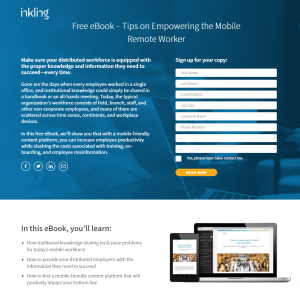
You can also use things like videos and reviews on your landing page. Videos have shown to be tremendously effective on landing pages because they’re visual content, and by now, you know the power of reviews and testimonials, so it’s not very surprising.
With a video, you can present the benefits of your product much clearer, and maybe even show how you can use your product out in the field.
Uncertainty is the biggest conversion killer, but by leveraging video, you remove any uncertainty about what your product is about.
On your landing page, you can run split tests on things like:
- Button color
- Headlines
- Copy
- Forms
- Page layout
- Images
All of these things, including many more, can have an impact on your bounce rate, and ultimately also your conversions, but it’s hard to know if you’re not testing, right?
Incentivize your audience
Incentivizes are amazing in marketing.
For instance, if I ask you to run a mile here and now, would you do it?
Probably not.
But if I gave you a car, would you do it?
Probably, right?
Incentivizing your audience as a brand is a super effective tactic as it can get your audience to perform the action you want them to.
By offering an incentive, you can spark an interest in the product you are hoping to sell, but at the same time, make your audience happy.
Let’s say you want your audience to sign up for your email address, and your end goal is to sell a course.
How do you get from the awareness stage to the conversion stage by leveraging content marketing?
You incentivize them, of course.
If you have an ebook that addresses something that you know a lot of people in your audience are wondering, you can offer that ebook in return for their email address.
And in the ebook that they get, you talk about your course and what benefits it has. as well as give the reader some real value.
And then, you email them back letting them know about your course: something they’ve already have had etched in their brain – thus making them more likely to find it interesting and have a go.
And the fact that you provided them with value by giving them something (the ebook) is an effective part as well.
This is exactly what Unbounce has done:
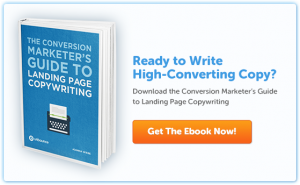
Build trust by leveraging customers
By now, you know the incredible power of online reviews and testimonials.
Therefore you should be using them as much as you can.
Even better, you should make them a part of your content strategy.
People trust their peers much more than they trust brands, and this is the reason why it has a greater impact in marketing than if the words are coming from your brand.
And it’s not so strange, really.
People know that brands only have one agenda: to sell more.
So obviously, all the efforts of the brand will be to help them get closer to that goal, right?
There are many different ways you can leverage the power of your audience, but one highly popular way is to implement user-generated content in your content marketing strategy.
Encourage your audience to share content and share it with you, and in return, you showcase it to your audience.
A study has found that 93% of consumers find UGC to be helpful when making a purchasing decision.
This proves the power that lies in UGC.
Another benefit of UGC is that your audience is creating the content for you.
Creating content is both difficult and time-consuming, and by using UGC, you can decrease the cost of your content creation.
Olapic found that 56% of consumers are more likely to purchase products after seeing it being featured in a customer photo. This is also the way you want to use user-generated content.
If you show your audience how your existing customers are benefiting from your products, you can create a demand, and at the same time make your prospects trust you more.
Improve your forms
A lot of times, forms are being used on landing pages.
Just take a look at the form om Salesforce’s landing page.
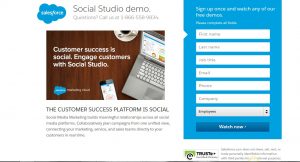
The form is amazing to be able to identify which stages your prospects are in the sales funnel, but also whether or not they’re prospects at all.
But the thing is, a faulty-optimized landing page can have negative effects on your conversion rates.
The form is a lot of the time where the conversion happens, but it is also the part that can scare people away. This is why it’s important to find a fine balance and to optimize your landing page so it converts.
The first thing you want to consider when optimizing your form is the number of fields.
On one hand, you want to get as much information about your audience as possible, but at the same time, the more fields you have, the more you decrease the completion rate. People don’t want to spend an hour filling in their favorite color, favorite candy, how tall they are, their favorite song, etc.
Only ask for the most relevant and important relevant information that you need to get them to convert.
The easier it is to complete your form, the more people will do it.
Next, you want to solve any form errors as quickly as you can. If the form says error when you fill it out, you’re almost 100% likely to miss out on a conversion.
Make sure your forms work properly, and that they load quickly.
Lastly, you want to consider the place of which you have your form. Remember that people scan a website according to an f-shape pattern, as well as look for key elements.
So if your form appears below the fold, there’s a chance they will miss it. Make it clearly visible, and have a clear call to action above it so people know what to do.

Mobile-optimization
If your website isn’t optimized for mobile yet, you’re in deep trouble.
Because a while back, it was announced that over 60% of searches are being made on mobile.
This means that if you haven’t optimized your website for mobile, more than 50% of people will come to your site, not be able to use it, and then leave.
What’s more, due to the increase in the number of mobile users, Google has made mobile friendliness a ranking factor in Google.
If your website isn’t optimized for mobile, it means that Google can punish you with lower rankings.
The single most important thing on your website is the user experience.
If your website offers a terrible user experience with long loading times, it can be the reason for your low conversion rates.
Moreover, you also want to design a website that is appealing and is memorable
Your website needs to “be” a character, and reflect a personality that you want your brand to have.
This allows you to stand out from the competition, but also build a deeper relationship with your audience since you come off as more human.
Conclusion
You’re investing all this time into creating content, but people don’t seem to be converting.
When you put time and energy into something, you want it to benefit you.
If your content isn’t converting, it might not be the fact that your content is terrible that makes your conversion rate low.
Your content may be amazing, but unless you optimize it for conversions, you’re not getting the most out of it.
By optimizing your content for conversions, you can squeeze the last marketing juice form your content and generate better results from your efforts.


